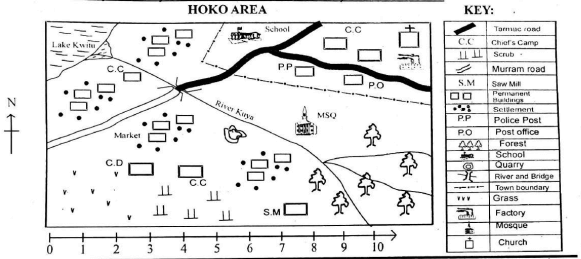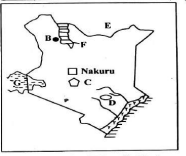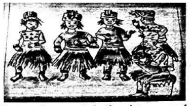Study the map of Hoko Area and answer questions 1 to 5.

- River kuya on the map flows from
- North West
- South West
- North West
- South East
- Jerrica was in the mosque. Which direction would she walk to reach the church?
- North West
- North East
- South West
- South East.
- Grade five learners took a walk to the shrubs to study the climate around the area. The climate was likely to be
- cool and wet
- hot and dry
- hot and wet
- cool.
- Njoroge was asked to describe the settlement pattern in the area covered by the map. The area has is likely to be
- linear
- sparse
- dense
- nucleated.
- Grade five learners walked around the area as they identify economic activities taking place. Which one of the following is not among the activities they found?
- Transport
- Trade
- Crop farming
- Communication.
- John was asked to name Bantus found in Kenya. Which one of the followingcommunities are not members of the Bantu language group?
- Mijikenda, pokomo, Agikuyu.
- Aembu, Ameru, Akamba.
- Giriama, Rabai, Chonyi.
- Luo, Kalenjin, iteso.
- Kamotho was asked to name the country that borders Kenya to the North West. Which country did he mention?
- Uganda
- Ethiopia
- South Sudan
- Somalia.
- Grade five learners were discussing the activities of various language groups in the pre-colonial period. Four learners wrote down the following
Nyawera: Bantus-Farming.
Lemayan: Nilotes-Pastoralism.
Onduso: Cushites - Trade.
Kamotho: Semites - Trade.
Who among the learners gave the wrong answer?- Nyawera
- Lemayan
- Onduso
- Kamotho.
- Mr. Kimotho wrote a chart with the following characteristics of a given climatic region.
- High rainfall.
- Low temperatures.
- Generally cool and wet throughout the year.
Which climatic region is described above?- Modified equatorial
- Mountain
- Tropical
- Desert.
- The element of a map that is used to tell the approximate distance of features on a map is
- Scale
- Compass
- Key
- Frame.
- Mr. Kilonzo asked his pupils to name African traditional methods of education. Three of the following are true except
- riddles
- story books
- apprenticeship
- song.
- During Social Studies lesson four learners were asked to write down statements about the Maasai community. They wrote the following points:
- Abdiaziz: They're Nilotic speakers.
- Odumo: They originated from Congo Forest.
- Maribe: They are pastoralists.
- Onyidho: They came from Southern Sudan.
Who among the learners gave a wrong answer?- Maribe
- Onyidho
- Odumo
- Abdiaziz.
- Which one of the following statements describe population density? The number of
- people living per square kilometre
- people in an area
- people per square meters
- adults per square kilometre.
Use the map of Kenya below to answer questions 14-15
- The Lake marked F is called Lake
- Magadi
- Victoria
- Turkana
- Nakuru
- The country marked E is called
- South Sudan
- Somalia
- Uganda
- Ethiopia.
- Grade five learners were asked by their teacher to name musical instruments from different communities in Kenya. Which one of the following instruments is correctly matched with the source Community?
- Soo-Mijikenda community.
- Nzumari-Kamba community.
- Abu-Luo community.
- Coro -Meru community.
- Learners in grade 5 were asked to discuss safety and etiquette while performing folk songs. Four learners responded as follows;
Chebet: Avoid overcrowding
Karissa: Avoid shouting
Jesse: Respect other singers as you sing
Michael: The message of the song does not matter during performance.
Who among the learners gave the wrong information?- Chebet
- Karissa
- Jesse
- Michael.
- Grade five learners were asked to name countries in Eastern Africa where the East African community Anthem is used officially. Which one of the following answers is not correct?
- Kenya
- Somalia
- Uganda
- South Sudan
- The diagram below shows a musical instrument commonly used by the Gusii community during folk song performance.
Which one of the following statements is true about the musical instrument?- It is known as Obokano.
- t's called wandindi.
- It's a melodic percussion instrument.
- It's a non-melodic percussion instrument.
- Grade four learners were asked to use hand signs for different sound. Millania made the sign below.
Which one of the following sounds did she sign?- doh
- reh
- so
- mi
- Learners were asked to write down the importance of caring for the musical instruments. Which one of the following statements is false regarding taking care of instruments?
- Saves time used in making new investments.
- Saves money used to buy new instruments.
- Saves resources used to make new instruments.
- Makes instruments to fade well.
- Four learners gave the following musical instruments.
Akelo - guitar
Wacike - Wandindi
Naliaka - drum
Wambui - adongo
Who among the following learners gave an example of melodic percussion instrument?
A. Akelo
C. Naliaka
B. Wacike
D. Wambui. - Grade five learners took part in performing a folk song. Who among the following is not a participant in a folk song?
- Soloist
- Instrumentalist
- Singers
- Song composer
- A church choir mentioned the word SAT during an event in school. What is SAT in full?
- Singer, Alto, Tradition.
- Soprano, Alto, Tenor.
- Soprano, Alto, Team.
- Singers, Adeudeu, Tenor.
- The picture below shows an instrumentalist. The instrument being played is called
- abu
- nzumari
- soo
- coro
- Kemboi drew a cow on a piece of paper. Which area in a work of art attracts the viewer's eye and holds interest?
- Texture
- Emphasis
- Form
- Balance.
- Grade 4 learners painted with the following colours on four walls. Which one of the colours used is a warm colour?
- Blue
- Green
- Purple
- Orange.
- Mbuma made a cup by use of plasticine. This process is referred to as
- creation
- sculpture
- modelling
- painting.
- Look at the picture below. Which letter shows light area?
- Fauzia wants to make the hand print pattern. Which of the following materials will not be used?
- Colours
- Brushes
- Papers
- Scissors
- The activity of making something look more attractive by putting things on it or around it is referred to as
- mounting
- decorating
- painting
- designing.
- Use the picture below to answer questions 32 and 33.
What are the people in the picture wearing on their hands?- Necklaces
- Bangles
- Earing
- Anklets.
- What will make them unique from other musical bands?
- Songs
- Voices
- Costumes
- Sizes
- Fabian made a pot using clay. Which technique can be used lto decorate the pot?
- Embedding
- Voices
- Drawing
- Texturing
- Grade 4 learners made a shaker using locally available materials. Below are the steps they used to make the shakers.
- Selecting materials needed.
- Putting wire into bottle tops.
- Making holes into bottle tops.
- Fixing the wire with bottle tops to the Y stick.
Rearrange the steps in the correct procedure.- i, ii, iii, iv
- ii, i, iii, iv
- i, iii, ii, iv
- iv, i, ii, iii
PART 2: Choose a section you have prepared for. Each section is 10 marks
CHRISTIAN RELIGIOUS EDUCATION
- The book of Mathew 25:14-30 tells the story of the parable of talents. What do we learn from the parable?
- We should use our talents to make us rich.
- We should use our talents to serve God.
- God doesn't want us to use our talents.
- Not everyone has a talent.
- Tabitha learned about the following values that every Christian should have. Which one is not?
- Honesty
- Responsibility
- Hard work
- Selfishness.
- In Genesis 1:26, 2:15, God gave human beings the following responsibilities except
- to take care of all domestic and wild animals
- to cultivate and care for plants
- to name all animals and birds
- to cut down all the trees in the environment.
- We learn from studying Christian Religious Education that children have the responsibility to
- help their parents at home by doing house chores
- do what they feel like any time they like
- watch television all day
- sleep for as long as they like.
- Grade five pupils learned that each one is given a talent according to
- one's abilities
- how rich you are
- how beautiful you look
- ones desire for more.
- The following are ways of discouraging child labour. Which one is not?
- Encouraging religious leaders to educate members of the church.
- Encouraging chiefs and community leaders to sensitize people of the community.
- Encouraging leaders to establish homes for orphans and homeless children
- Encouraging children to look for well-paying jobs.
- Wendy was passing near a coffee plantation when she noticed a boy who looked almost her age struggling to carry a large basket filled with coffee berries. As a Christian, what should she do?
- Go to the owner of the plantation and blackmail him.
- Join the boy and work there as well.
- Go to the police and report it.
- Keep quiet and mind her own business.
- Selina was given the following school rules during her admission. Which one of them is not a school rule?
- Obey your teachers and student leaders.
- Use polite language at all times.
- Wear clean school uniform all the time.
- Obey and help your parents.
- The following statements are true about the first human beings except
- the snake convinced Eve to eat from the tree of knowledge
- Eve ate the fruit and gave it to Adam to eat too
- they remained in the garden of Eden for eternity
- the relationship between the first humans and God was affected.
- It is important for families to be united. Which of the following does not contribute to family unity? A.
- Helping with house chores.
- Praying together.
- Sharing meals.
- Ignoring instructions.
- Delphine listed the importance of the Bible on a manilla paper. Which one is an importance of the Bible?
- t is used in rebuking error and correcting faults.
- It is an interesting history book.
- We can use it to hide money.
- It can be used to swear and everyone will believe you.
- From the story of Peter and John, we learn that
- we should always speak the truth about Jesus even when facing challenges
- we should disobey authorities when we think they are being unfair
- we should only preach the gospel in church
- we should avoid interacting with non- believers
- The bible tells us of a king who had great wisdom. Who among the following Kings is he?
- King Saul
- King David
- King Solomon
- King Jeroboam.
- Karina found some girls smoking behind the dormitory and she told them it was against the rules and it was bad for their health. What value did Karina display?
- Courageous
- Self-control
- Peace
- Righteousness.
- One of the disciples of the early church who was stoned and died was called
- Peter
- John
- Stephen
- Noah
ISLAMIC RELIGIOUS EDUCATION
- Grade 5 learners were searching on the Internet the pillars of Islam. Which pillar did they find out as the second? To believe in
- books
- angels
- Allah
- the last day.
- According to Suratul Kawthar, a Muslim is commanded to do two things to Allah alone. What are the two things?
- Prayer and sacrifice.
- Sacrifice and hajj.
- Prayer and saum.
- Hajj and zakah.
- The following are lessons learnt from Suratul Maun. Which one is it? We should
- sacrifice to Allah alone
- be honest
- offer prayers on time
- push away the orphans.
- The Quraish were given many favours by Allah. What did Allah require them to do in return?
- Worship him.
- Feed others.
- Do business.
- Worship the prophet.
- What important lesson do Muslims learn from the story of Abraha as mentioned in Suratul Fiyl?
- Elephants are good fighters.
- Abraha converted to islam.
- Birds can fight.
- Allah is very powerful.
- Amina did a bad deed and followed it with a good one. From which hadith did she learn this? Hadith on
- tawakkal
- good manners
- greetings
- pillars of islam.
- Islamic greetings promote the following except
- Hatred
- Love
- Peace
- Harmony.
- Grade 5 learners were discussing in pairs a hadith on the importance of seeking knowledge. Which hadith did they note do in their books?
- Seek knowledge even if it means going to china.
- Girls should not seek knowledge.
- Seeking knowledge is obligatory on every muslim.
- Seeking knowledge is compulsory only on boys.
- Grade 5 learners searched in the Internet on the attributes of Allah. Which attribute described Allah as the forgiver?
- Alaliim
- Al wahiid
- Alhafeedh
- Al ghaffaar.
- Shaaban listed down differences between angels and human beings. Which quality was not found in angels? They
- disobey Allah sometimes
- never eat
- are neither males nor females
- are created from light..
- Which one of the following miracles was performed by nabii Issa?
- Changing stick into a snake.
- Shiny hand.
- Resurrected the dead.
- Thrown into the fire but the fire did not burn him.
- The prophet (S. A.W), Preached secretly for years how many years?
- 3
- 4
- 6
- 10
- In which posture of swalah do we the dua below. "Subhaana rabiyal aala"
- Rukuu
- Itdaal
- Sujuud
- Tashahud.
- Which pillar of islam is conducted by Muslims atleast once in their lifetime?
- Zakah
- Hajj
- Saum
- Swalah.
- Aisha performed a certain long prayer after Isha in the month of Ramadan. Which prayer was she
performing?- Tahajjud
- Witr
- Istisqai
- Taraweh.
MARKING SCHEME
SOCIAL STUDIES
- D
- B
- B
- D
- C
- D
- C
- C
- B
- A
- B
- C
- A
- C
- D
- C
- D
- B
- C
- B
- D
- C
- D
- B
- C
- D
- D
- C
- D
- D
- A
- B
- C
- A
- C
CRE
- B
- D
- D
- A
- A
- D
- C
- D
- C
- D
- A
- A
- C
- B
- C
IRE
- B
- A
- C
- A
- D
- B
- A
- C
- D
- A
- C
- A
- C
- B
- D
Join our whatsapp group for latest updates
Tap Here to Download for 30/-
Get on WhatsApp for 30/-
Download Creative Arts And Social Studies Questions and Answers - Grade 5 End Term 1 Exams 2023 Set 2.
Tap Here to Download for 30/-
Get on WhatsApp for 30/-
Why download?
- ✔ To read offline at any time.
- ✔ To Print at your convenience
- ✔ Share Easily with Friends / Students







